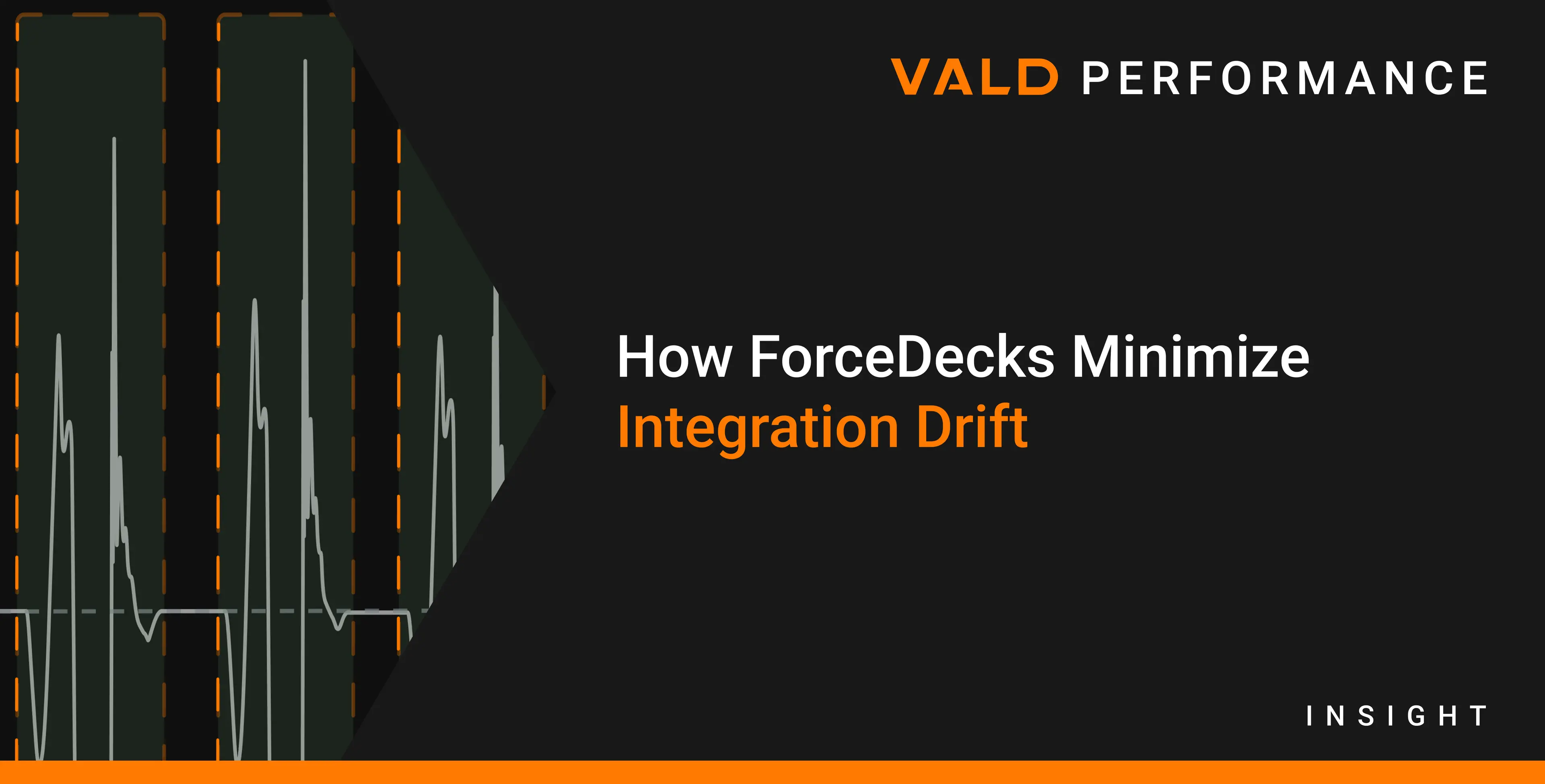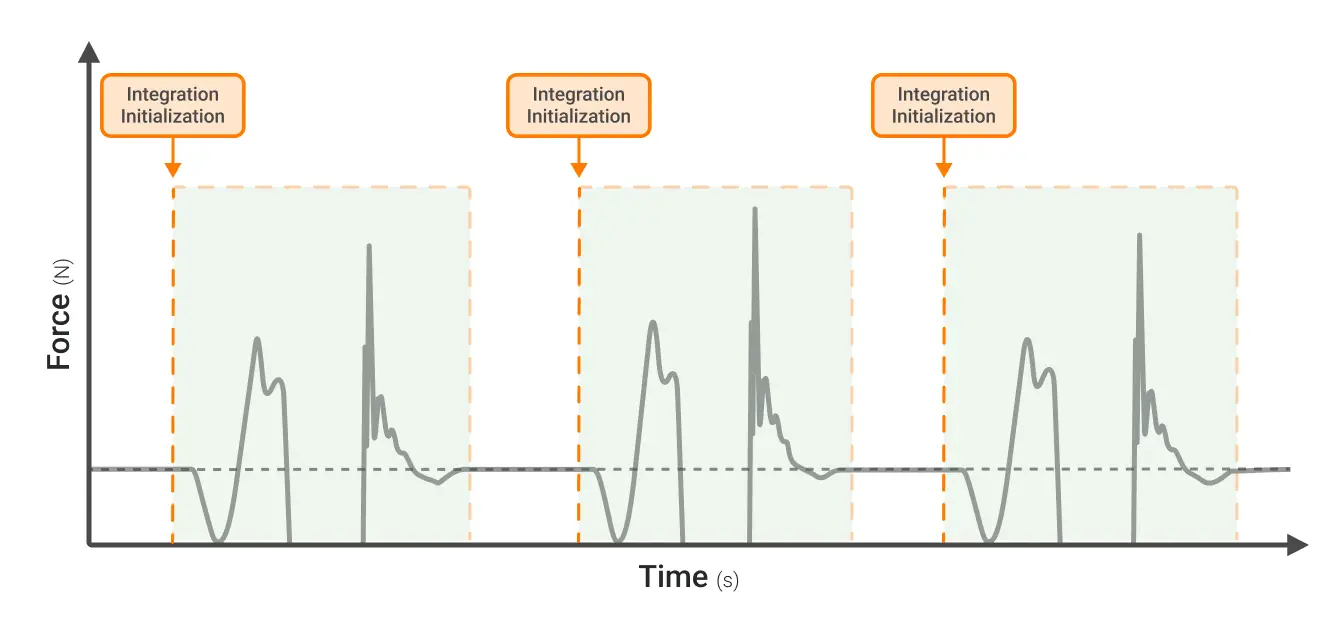How ForceDecks Minimize Integration Drift
Available in:
EN
While force plates only directly measure force and time, they can use numerical integration to transform this raw force data into a range of other metrics that give meaningful insights into human motion and neuromuscular performance.
However, there are a number of potential challenges to maintaining data accuracy during this transformation process. The most common is poor bodyweight measurement, which can cause a range of inaccuracies in downstream metrics that are derived from it.
A lesser-known challenge for force plates is integration drift – the gradual accumulation of small inaccuracies over time, potentially leading to large errors if left unchecked.
ForceDecks [allows] continuous, unlimited-rep, multi-test recordings that provide practitioners with flexibility and save precious time…
In this article, we delve into how ForceDecks minimizes these potential effects, delivering accurate and reliable results while allowing continuous, unlimited-rep, multi-test recordings that provide practitioners with flexibility and save precious time.
What is numerical integration?
Numerical integration is a mathematical technique used to approximate the area under a curve (i.e., the definite integral of a function) by breaking the area into smaller segments and summing them (Mathematics LibreTexts, 2023). It is commonly used when dealing with real-world sampled data when an analytical solution for integration is not possible.
In the context of force plates, numerical integration plays a crucial role in converting force data into velocity and displacement metrics.
…numerical integration plays a crucial role in converting force data into velocity and displacement metrics…
To understand how this works, we can examine the steps for the calculation of velocity and displacement:
- Force: ForceDecks directly measures the force applied by the subject.
- Acceleration: The measured force is used to calculate acceleration by rearranging Newton's second law of motion (F = ma) to solve for acceleration (a = F / m).
- Velocity and Displacement: Using acceleration, numerical integration is applied to calculate velocity and displacement. Velocity is the integral of acceleration with respect to time (v(t) = v0 + ∫ (a(t)dt)), and displacement is the integral of velocity with respect to time (d(t) = d0 + ∫ (v(t)dt)).
What is integration drift?
Integration drift is the accumulation of small errors during numerical integration. Numerical integration assumes a consistent rate of change within each time step.
However, real-world data is continuous, not discrete. This difference introduces a small error at each time step that grows as integration progresses and small errors are summed. Integration drift is a fundamental challenge when using numerical methods for integration (Banks et al., 2022).
For this reason, some force plate systems limit recordings to a single rep at a time. ForceDecks, however, allows continuous recording and unlimited reps, while using two primary methods to minimize integration drift. This functionality saves practitioners time by allowing multiple reps and tests to be conducted within the same recording.
How does ForceDecks minimize integration drift?
ForceDecks starts a fresh numerical integration before each repetition to remove bias, address nonlinear effects [and] minimize error accumulation.
ForceDecks has two primary methods for combating integration drift:
- Frequent Integration Initialization: ForceDecks starts a fresh numerical integration before each repetition to remove bias and address nonlinear effects. Integration drift is zero when integration begins and grows over time. When integration is restarted, the integration drift goes back to zero. ForceDecks takes advantage of this by restarting integration right before each repetition, minimizing error accumulation (Calame & Kuster, n.d.). The exact moment when integration is restarted can be customized in ForceDecks’ Settings.
- High Sampling Rate: ForceDecks can sample data at a rate of 1,000Hz. This means that each time step during its numerical integration is one millisecond. Shorter time steps reduce integration drift because they better follow the continuous nature of real-world force data and rapid changes in the signal over time.

Countermovement jump (CMJ) force trace indicating integration initialization at the start of each repetition.
Quantifying Integration Drift in a Countermovement Jump
Integration drift is an inherent byproduct of numerical integration, but its impact on ForceDecks metrics is negligible. To illustrate this, we performed a computer simulation to analyze how integration drift affects (or, rather, does not affect) jump height in a CMJ.
To illustrate this, we performed a computer simulation to analyze how integration drift affects (or, rather, does not affect) jump height in a CMJ.
We created a force trace for a simulated CMJ using continuous splines to model realistic motion and added significant random noise to simulate a worst-case scenario for integration drift variability. This generated a “gold standard” force-trace sampled at 10,000Hz.
To mimic a ForceDecks recording, we downsampled the 10,000Hz force trace to 1,000Hz. This process inherently introduces small differences due to reduced data resolution, which we then quantified by numerically integrating the two force traces.
After double integration, the displacement curves derived from both the gold standard (10,000Hz) and downsampled (1,000Hz) traces revealed a slight divergence over time. This divergence or integration drift, increased with the duration of integration but remained minimal.
…jump height was 0.450m for the gold standard and 0.448m for the downsampled force-trace, resulting in an absolute difference of only 2mm or 0.383%.
The maximum displacement, representing jump height, was 0.450m for the gold standard and 0.448m for the downsampled force-trace, resulting in an absolute difference of 2mm or 0.383%. Over the course of a 2.5-second CMJ, the maximum drift between the displacement curves reached only 7mm.
Reviewing these results, the effect of integration drift is negligible when sampling at a sufficient rate and integration is restarted at regular intervals.
Conclusion
Force plates use numerical integration to convert force data into metrics which provide valuable insights into human motion. Integration drift, the gradual accumulation of errors during this process, can compromise accuracy if left unchecked.
ForceDecks mitigates errors from integration drift by using a high sampling rate and frequently initializing integration. This maximizes data accuracy while enhancing practitioners’ workflows by allowing unlimited reps and multiple tests in a single recording.
If you would like to learn more about how ForceDecks minimizes integration drift to improve the reliability of performance and movement assessments, please reach out here.
References
- Mathematics LibreTexts. (2023, May 14). 2.5: Numerical Integration. https://math.libretexts.org/Courses/Cosumnes_River_College/Math_401:_Calculus_II_-_Integral_Calculus/02:_Techniques_of_Integration/2.05:_Numerical_Integration
- Banks, A., He, R., Dillman, L., McGibbon, C., & Sensinger, J. (2022). A Comparison of Force-Plate Based Center of Mass Estimation Algorithms. 2022 International Conference on Rehabilitation Robotics (ICORR), 1-5. https://doi.org/10.1109/icorr55369.2022.9896525
- Calame, C., & Kuster, M. S. (n.d.). Jump Height Determination with Force Plate for Continuous Jumps. https://isbweb.org/images/conf/2001/Longabstracts/PDF/0900_0999/0951.pdf
